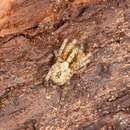en
names in breadcrumbs


The spider family Anyphaenidae (ghost spiders) has a worldwide distribution and includes more than 500 described species (521 according to Platnick 2013), mainly from the American tropics. Just a few dozen species are known from North America north of Mexico (in this region, Anyphaena and Hibana are widely distributed, Wulfila and Arachosia are mainly eastern, and Pippuhana and Lupettiana are southern) (Richman and Ubick 2005). These spiders are very active, mainly nocturnal hunters (Hibana are diurnal). Their continuous activity, which is unusual for spiders, may be fueled by the consumption of energy-rich plant nectar taken from extra-floral nectaries or flowers (Taylor and Foster 1996). Although the ghost spiders were long treated as comprising a subfamily within the family Clubionidae. Lehtinen (1967) and Platnick (1974) provided evidence to successfully make the case for their status as a distinct family. Like spiders in the majority of spider families, anyphaenids have eight eyes.
North American anyphaenids are found on vegetation, among dead leaves, and under loose bark and rocks (especially in winter). In eastern North America, most species are long-legged and tend to be collected by sweeping foliage in fields and meadows, whereas in western North America most species have shorter legs and tend to be found in leaf litter and beneath stones and logs (Platnick 1974). Anyphaenids are wandering hunters, not web-builders, and make little use of silk beyond building sac-like retreats and constructing egg sacs. At least one species (Hibana velox) is known to eat insect eggs (Richman et al. 1983) and feed at extrafloral nectaries (Taylor and Foster 1996). Some amphyaenids are believed to be important in the control of certain tree crop pests, such as aphids (Richman 2003).
(Richman and Ubick 2005; Bradley 2013)
Anyphaenidae is a family of araneomorph spiders, sometimes called anyphaenid sac spiders. They are distinguished from the sac spiders of the family Clubionidae and other spiders by having the abdominal spiracle placed one third to one half of the way anterior to the spinnerets toward the epigastric furrow on the underside of the abdomen. In most spiders the spiracle is just anterior to the spinnerets. Like clubionids, anyphaenids have eight eyes arranged in two rows, conical anterior spinnerets and are wandering predators that build silken retreats, or sacs, usually on plant terminals, between leaves, under bark or under rocks. There are more than 600 species in over 50 genera worldwide.
The family is widespread and includes such common genera as Anyphaena (worldwide except tropical Africa and Asia) and Hibana (New World). Only one species (A. accentuata) occurs in northwestern Europe.
Species in the latter genus are important predators in several agricultural systems, especially tree crops. They are able to detect and feed on insect eggs, despite their poor eyesight. They share this ability at least with some miturgid spiders.
As of January 2023, the World Spider Catalog accepts the following genera:[1]
Anyphaenidae is a family of araneomorph spiders, sometimes called anyphaenid sac spiders. They are distinguished from the sac spiders of the family Clubionidae and other spiders by having the abdominal spiracle placed one third to one half of the way anterior to the spinnerets toward the epigastric furrow on the underside of the abdomen. In most spiders the spiracle is just anterior to the spinnerets. Like clubionids, anyphaenids have eight eyes arranged in two rows, conical anterior spinnerets and are wandering predators that build silken retreats, or sacs, usually on plant terminals, between leaves, under bark or under rocks. There are more than 600 species in over 50 genera worldwide.
The family is widespread and includes such common genera as Anyphaena (worldwide except tropical Africa and Asia) and Hibana (New World). Only one species (A. accentuata) occurs in northwestern Europe.
Species in the latter genus are important predators in several agricultural systems, especially tree crops. They are able to detect and feed on insect eggs, despite their poor eyesight. They share this ability at least with some miturgid spiders.